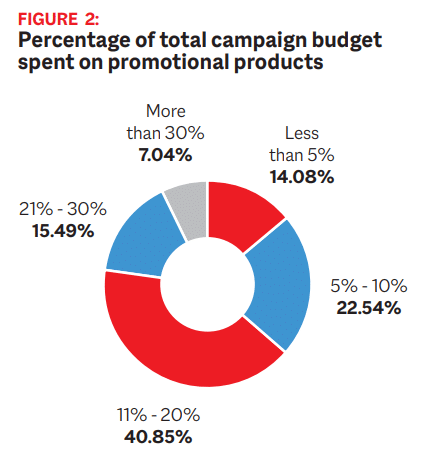Presidents don’t get elected without the promotional products industry. Since the nation’s first president, George Washington, promoted his campaign through commemorative buttons, promo has been a vital and unmistakable part of every election cycle. About 1 in 10 Americans display a yard sign of their preferred candidate as an election approaches.
Ahead of the 2024 presidential election, PPAI Research took a detailed look at the effect of promotional products and how they are used in campaigns through two different perspectives.
- The first of these perspectives aims to determine the way various political campaigns use promotional products, as well as their preferences within the market. This survey took insights from approximately 250 campaign workers.
- Secondly, this study also takes a look at the influence of promo in shaping voter perception via survey responses from a diverse range of more than 1,000 voters.
“Political campaigns are pivotal in shaping the demand within the promotional products industry, significantly influencing trends and purchasing behaviors across PPAI member suppliers and distributors,” says Alok Bhat, PPAI’s market economist and senior manager of research.
The majority of voters (53.3%) in the study indicated that promotional products positively or very positively influence their view of a candidate. These insights come bolstered by a moment when the nation is feverishly being recruited to the polls by both parties.
After more than six months of an election year that seemed to be droning on with two candidates who had already sold their fair share of campaign merch over the past four to eight years, election-related promo products got a shot in the arm when President Joe Biden dropped out of the 2024 race, paving the way for Vice President Kamala Harris to launch her campaign.
- A flurry of campaign donations for Harris helped fund promo merch to help announce the new candidate to the nation, which led to a surge in demand for Harris/Walz hats made by Newark-based supplier Unionwear, including a viral camouflage hat.
- Once the Harris/Walz ticket became official, Gill Studios – the No. 26 supplier in the PPAI 100 – saw a healthy demand for election merch, according to Cindy Scardino, the company’s marketing project manager.
“Gill has received a significant number of orders for either Harris or Harris/Walz, with the bulk of the union-made orders being ever-popular signs and bumper stickers, followed by a variety of stickers, both stock and custom,” Scardino told PPAI Media one week into the Harris/Walz campaign.
Insights From Political Campaign Workers
PPAI Research surveyed approximately 250 respondents who have been actively involved in a political campaign recently. Participants ranged in:
- Role: Campaign managers (the most represented role at 32%), marketing directors, communication directors, fundraising coordinators and more participated.
- Size of campaign team: Respondents worked for campaigns anywhere from single-digit team members to campaigns with more than 200 team members.
- Political Party: Both Republicans and Democrats are represented, plus a minority of respondents from campaigns for independent candidates.
“The survey data, segmented by political affiliation, provides critical insights into the preferences and effectiveness of promotional products, revealing their role in both voter engagement and financial outcomes for campaigns,” Bhat says.
The most preferred promotional products among campaign representatives were hats and caps, with 69% of respondents having favorable opinions on the effectiveness of campaign headwear. Democratic campaigns prefer them slightly more than Republicans.
Mitch Cahn, founder and president of Unionwear, confirmed that by mid-August, Unionwear had sold approximately 100,000 Harris campaign hats, outpacing the initial demand the supplier saw for Trump’s “Make America Great Again” hats in 2016.
Political T-shirts come in just behind hats/caps, with 67.1% of respondents seeing them as effective. The flag and banners/posters/signs categories both received greater than 40% positive results, and buttons/badges and stickers both received more than 30%. (See Figure 1.)

Budget allocation results show that most campaigns allocate a significant portion of their marketing money for promotional products. A healthy 40.85% of respondents dedicate 11%-20% of their total campaign budget to promo products. The second most common promo ratio is 5%-10% of the campaign budget. (See Figure 2.)

These are fairly high allocation percentages considering the sometimes eye-popping prices we see referenced for political television ads. It’s also a reminder that campaigns for down-ballot or local offices that may not devote big investments in television ads do rely on promotional products.
Both Democratic and Republican campaigns measure their return on investment in promo primarily through event attendance. Social media engagement, fundraising success and merchandise sales are also reported measures of ROI.
Perhaps one of the most surprising insights from the survey is that one political party has much more confidence in promo’s ability to engage voters than the other, at least by percentage. A majority 61.29% of Democrats consider promotional products effective, compared to 30.30% of Republicans. (See Figure 3.)

However, both parties use promo to help finance their campaigns. Nealy two-thirds (61.29%) of Democrats surveyed view merchandise sales as having a positive financial impact on their campaigns, compared to 54.54% of Republicans.
Additional insights:
- Democratic campaigns showed a preference for promo that could be personalized and create an emotional connection.
- Republican candidates focused more heavily on visibility through traditional products like yard signs or banners.
But How Do The Voters Feel About Promo?
In addition to campaign staffers, PPAI Research surveyed more than 1,000 voters, more than 80% of whom were either Republicans or Democrats of all ages and incomes and who lived across the Midwest, Northeast, South and West.
T-shirts are the most commonly received promotional products across all parties, with 45.11% of voters claiming to have received one. Hats and caps were next on the list, and Republican voters showed a stronger preference than Democrats. Buttons and badges saw usage by 36.91% of voters, with Democrats receiving more than Republicans. (See Figure 4.)

The study also aimed to determine where most voters were receiving the promotional products they were collecting from various campaigns. Distribution channels are a key strategic point for a marketing approach that requires getting into the hands of end users.
For both parties, community events were the most common environments in which voters said they have received campaign promo. Door- to-door canvassing and fundraising events also proved to be tried-and- true methods for distributing promo items. (See Figure 5.)

“Community events and door-to-door canvassing are critical channels for reaching voters, particularly for Democrats and independents,” Bhat says. “These methods foster personal connections and direct voter engagement.”
Earlier, we highlighted that Democratic campaigns expressed a higher enthusiasm for the effectiveness of promo products than Republican campaigns. Well, the two surveys have produced an interesting contrast. A slightly higher percentage of Republican voters (56.4%) expressed being positively influenced by political merch than Democratic voters (53.3%).
When it comes to general voter influence on a political nominee for office, regardless of party, 37.85% of respondents agree that promotional products influence their decision to support a candidate.
For deeper and additional insights – including specific promotional product preferences broken down by political party – full reports will be available at PPAI.org/premium-research.
Auping is a news editor at PPAI.


